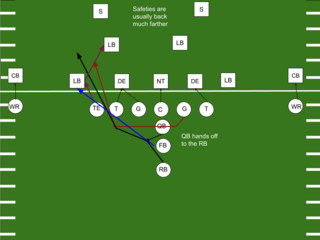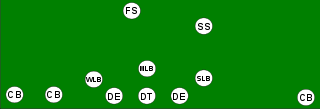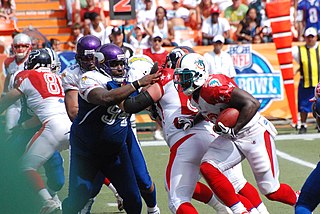Related Research Articles

In gridiron football, a lineman is a player who specializes in play at the line of scrimmage. The linemen of the team currently in possession of the ball are the offensive line, while linemen on the opposing team are the defensive line. A number of NFL rules specifically address restrictions and requirements for the offensive line, whose job is to help protect the quarterback from getting sacked for a loss, or worse, fumbling. The defensive line is covered by the same rules that apply to all defensive players. Linemen are usually the largest players on the field in both height and weight, since their positions usually require less running and more strength than skill positions.

Linebacker (LB) is a playing position in gridiron football. Linebackers are members of the defensive team, and line up three to five yards behind the line of scrimmage and the defensive linemen. They are the "middle ground" of defenders, playing closer to the line of scrimmage than the defensive backs (secondary), but farther back than the defensive linemen.

The tight end (TE) is an offensive position in American football, arena football, and Canadian football. It is a hybrid that combines the characteristics and roles of both an offensive lineman and a receiver. As part of the receiver corps, they play inside the flanks (tight), contrasted with the split end who plays outside the flanks (wide). Like offensive linemen, they are usually lined up on the offensive line and are large enough to be effective blockers. On the other hand, unlike offensive linemen, they are eligible receivers and potent weapons in a team's offensive schemes.
Strategy is a major part of American football.

The 46 defense is an American football defensive formation, an eight men in the box defense, with six players along the line of scrimmage. There are two players at linebacker depth playing linebacker technique, and then three defensive backs. The 46 defense was originally developed and popularized with the Chicago Bears by their defensive coordinator Buddy Ryan, who later became head coach of the Philadelphia Eagles and Arizona Cardinals.
In American football, a zone blitz is a defensive tactic that sends additional players to rush the opposing team's quarterback, whilst also unexpectedly redirecting a supposed pass rushing player into pass coverage instead. This tactic also includes zone coverage.

In American football, blocking or interference involves legal movements in which one player uses his body to obstruct another player's path. The purpose of blocking is to prevent defensive players from tackling the ball carrier, or to protect a quarterback who is attempting to pass, hand off or run the ball. Offensive linemen and fullbacks tend to do the most blocking, although wide receivers are often asked to help block on running plays and halfbacks may be asked to help block on passing plays, while tight ends perform pass blocking and run blocking if they are not running routes to receive passes. Overall, blocking is a skill that virtually every football player may be required to do at some point, even defensive players in the event of a turnover.

The Tampa 2 is an American football defensive scheme popularized by the Tampa Bay Buccaneers National Football League (NFL) team in the mid-1990s–early 2000s. The Tampa 2 is typically employed out of a 4–3 defensive alignment, which consists of four linemen, three linebackers, two cornerbacks, and two safeties. The defense is similar to a Cover 2 defense, except the middle linebacker drops into a deep middle coverage for a Cover 3 when he reads a pass play.

In American football, the specific role that a player takes on the field is referred to as their "position". Under the modern rules of American football, both teams are allowed 11 players on the field at one time and have "unlimited free substitutions", meaning that they may change any number of players during any "dead ball" situation. This has resulted in the development of three task-specific "platoons" of players within any single team: the offense, the defense, and "special teams". Within these three separate "platoons", various positions exist depending on the jobs that the players are doing.
There are several defensive formations commonly used in eight-man football. Defensive formations are classified by the total number of linemen and linebackers in the formation. The three basic types of formations in eight-man football are seven-man fronts, six-man fronts and five-man fronts.

The triple option is an American football play used to offer six ways to move the football forward on the field of play. The triple option is based on the option run, but uses three players who might run with the ball instead of the two used in a standard option run.
In American football, a play is a close-to-the-ground plan of action or strategy used to move the ball down the field. A play begins at either the snap from the center or at kickoff. Most commonly, plays occur at the snap during a down. These plays range from basic to very intricate. Football players keep a record of these plays in a playbook.

In American football, a power run is a running play used out of a variety of offensive formations using two backs.

In American football, the 3–4 defense is a common defensive alignment consisting of three down linemen and four linebackers. It is called a "base defense" because it will readily switch to other defensive alignments as circumstances change. Alternatively, some defenses use a 4–3 defense: four down linemen and three linebackers.

Zone coverage is a defensive scheme in gridiron football used to protect against the pass.

In American football, a 4–3 defense is a defensive alignment consisting of four down linemen and three linebackers. It is called a "base defense" because it is the default defensive alignment used on "base downs". However, defenses will readily switch to other defensive alignments as circumstances change. Alternatively, some teams use a 3–4 defense.

In American football, the 3–3–5 defense is a defensive alignment consisting of three down linemen, three linebackers, and five defensive backs. The 3–3–5 defense can also be referred to as the 3–3 stack or the spread defense. It is one form of the nickel defense, a generic term for a formation with five defensive backs. Veteran college football defensive coordinator Joe Lee Dunn is widely credited with being the main innovator of the 3–3–5 scheme.
The following terms are used in American football, both conventional and indoor. Some of these terms are also in use in Canadian football; for a list of terms unique to that code, see Glossary of Canadian football.

A defensive tackle (DT) is a position in American football that typically lines up on the line of scrimmage, opposite one of the offensive guards; however, he may also line up opposite one of the offensive tackles. Defensive tackles are typically the largest and strongest of the defensive players. Depending on a team's defensive scheme, a defensive tackle may be called upon to fill several different roles. These may include merely holding the point of attack by refusing to be moved, or penetrating a certain gap between offensive linemen to break up a play in the opponent's backfield. If a defensive tackle reads a pass play, his primary responsibility is to pursue the quarterback, or simply knock the pass down at the line if it is within arm's reach. Other responsibilities of the defensive tackle may be to pursue the screen pass or drop into coverage in a zone blitz scheme. In a traditional 4–3 defense, there is no nose tackle. Instead there are a left and a right defensive tackle. Some teams, especially in the National Football League (NFL), have a nose tackle in this scheme, but most of them do not.